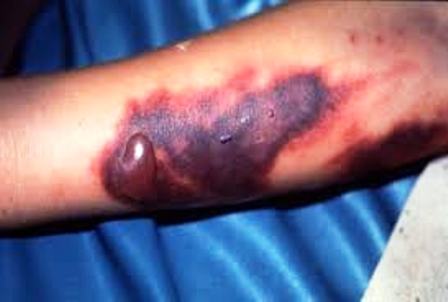Scientists use portable sequencing device to rapidly identify Lassa fever virus strains

For the first time during an ongoing Lassa fever outbreak, scientists have used rapid, portable genomic sequencing technology to identify viruses without prior knowledge of the cause of disease.
This enabled researchers to allay fears and direct the public health interventions to limit the spread of the virus and help to protect more people from disease.
The research, conducted during the 2018 Lassa fever epidemic in Nigeria, was carried out by scientists from Public Health England (UK), the Bernhard Nocht Institute for Tropical Medicine (Germany)and Irrua Specialist Teaching Hospital (Nigeria), in collaboration with the Nigeria Center for Disease Control (NCDC) and the World Health Organization (WHO), was published in the journal Science today, January 4, 2019.
Lassa fever is caused by a virus carried in the urine or faeces of infected rats. The virus causes fever, weakness, muscle pain and seizures, and is frequently fatal. Lassa virus occurs endemically in West Africa and while it regularly causes small outbreaks, an outbreak of the virus in the area in early 2018 led to 376 confirmed cases within a few months– more than the combined total for the three previous years.
The sudden upsurge in cases raised concerns that a new, highly transmissible form of the virus had evolved, able to pass from person to person more effectively than previous strains.
In order to better understand the reasons for the heightened number of cases, the NCDC, together with the WHO, commissioned the research team to analyse patient samples to understand if the virus had an increased transmission potential. The research builds on work that was carried out by PHE and BNITM during the 2014-2016 Ebola outbreak.
The team, working at the Irrua Specialist Teaching Hospital (ISTH) in Irrua, Nigeria, used Oxford Nanopore Technology‘s portable device to rapidly sequence the genetic code of 120 virus samples.
Traditionally, genomic assays used in the field required researchers to look at one genetic marker or virus strain at a time. However, this time a different approach was used, in combination with DNA sequencing, and known as metagenomics, which enabled the team to test for multiple different variations of Lassa virus genome,which is known to be highly diverse– speeding up the process of identifying the strains responsible for causing illness in this outbreak.
The approach gives insights into the genetic material of an entire virus population at a specific point in time.
The researchers found that the strains in the samples weren’t all closely related, suggesting that there wasn’t a single source of the virus that then spread from person to person. Instead, there were lots of different strains, suggesting multiple different instances of contraction from rodents.
These early, rapid results allowed teams on the ground to continue focusing the public health response on community engagement around rodent control, environmental sanitation and safe food storage rather than shifting to solely focusing on addressing person to person spread.
The analysis revealed a great deal of diversity and indicated mixing with Lassa virus strains of the previous year’s outbreaks.
“By using this technology to look at the Lassa virus family tree and comparing samples from this outbreak to those from previous years, we were able to exclude human-to-human transmission as the reason for the surge in cases” said Prof. Stephan Günther, head of the Virology Department at BNITM, explaining the results. “Instead, a frequent transmission from animals to humans seems to be the cause of the high case numbers.”
Professor Miles Carroll, Head of Research and Development of the National Infection Service at Public Health England, said:“Viruses are constantly changing, becoming more or less infectious and deadly over time. By studying their genetic code, we can better understand where the virus has come from and how it spreads.”
“Our previous tools to probe viral genomes took over a month to provide insights. Now, we can view results in as little as one day and in a field situation, guiding the public health interventions we deliver and ensuring we can act fast to stop more people becoming ill.
“Human-to-human transmission of viruses is something we always want to avoid, but in this instance the evidence indicated that we also needed to act in other areas for maximum impact.”
The Chief Medical Director of ISTH, Prof Sylvanus Okogbenin, said that “the result of the sequencing reassured managing Clinicians in ISTH, the main centre for the diagnosis and treatment of Lassa fever in Nigeria.
“I’d like to congratulate the team for the feat.The institution is very willing to collaborate further to ensure that on-site sequencing is a regular feature of its institute of Lassa fever research and control”.
Dr Chikwe Ihekweazu the Director General of NCDC added that “the results from this study, which were made available to NCDC as they became available, were critical in enabling us provide answers to questions during the outbreak and focus response measures appropriately.
“We are proud that all the sequencing was done onsite in ISTH, and will work with our partners to increase capacity for metagenomics in Nigeria”
The real-time, portable DNA sequencing technology used in this study has applications beyond Lassa fever. By being able to look at lots of different pathogen sequences in one go, the technology could be applied to previously unknown pathogens. This is important because international health agencies have predicted that an unknown ‘Pathogen X’ could cause the next major outbreak.
This new technology has the potential to enable scientists on the ground during an outbreak to rapidly study the pathogen genome without necessarily knowing what it is they are looking for.
About author
You might also like
NAFDAC, chemical manufacturers agree to explore international market
The National Agency for Food and Drug Administration and Control NAFDAC and manufacturers of chemical products in Nigeria have agreed to explore the international market to enhance the nation’s foreign
Revealed: Health ministry yet to get 2015 bugetary allocation
● Health budget continues to decline ● Nigeria maintains one of world’s lowest health budget Less than four months before the end of 2015, the
Locally produced Indomie Noodles safe – NAFDAC assures consumers
The National Agency for Food and Drug Administration and Control (NAFDAC) has assured consumers of the safety of all brands of Indomie Noodles produced in the country. This was made






0 Comments
No Comments Yet!
You can be first to comment this post!